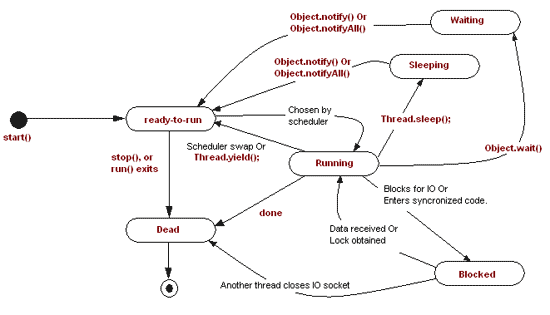- 《线程池:线程池资源回收策略修改》
郭源潮1
基于可变参模板的线程池项目线程池C++11C++17c++
当线程池出ThreadPool出作用域析构时,此时任务队列里如果还有任务,是等任务执行完再结束,还是不执行剩下的任务了?这其实是两种设计,线程池都析构了,任务也就不需要了。但是,如果要设计一个通用的线程池,线程池析构是要等任务执行完成的,用户提交的任务可能比较耗时,任务还没执行完,线程池就出了作用域析构了。之前的代码://定义线程函数线程池的所有线程从任务队列里面消费任务voidThreadPoo
- C++多线程常见的数据竞争模式及示例分析
老猿讲编程
c++开发语言多线程数据竞争
一、简单竞争最简单的数据竞争是最常见的一种:两个线程在没有任何同步的情况下访问一个内置类型的变量。很多时候,这种竞争是良性的(代码统计一些允许不精确的统计信息)。intvar;voidThread1(){//在一个线程中运行。var++;}voidThread2(){//在另一个线程中运行。var++;}但有时这种竞争是极其有害的(例如,如果var是在计算你的钱的数量时)。二、线程不友好的引用计数
- C++并发编程有什么最佳实践?
c++
在C++并发编程中,遵循最佳实践可以显著提升代码的效率、可维护性和可扩展性。以下是一些关键的最佳实践:使用线程池管理线程线程池可以预先创建一组线程,并在需要时将任务分配给这些线程。这种方式减少了创建和销毁线程的开销,提高了程序性能。例如:cpp复制autopool=std::make_shared(std::thread::hardware_concurrency());pool->push(st
- 深入理解 C++11 多线程编程:从入门到实践
小河cpp
c++开发语言
C++多线程编程是指使用C++提供的多线程库来并行执行代码块,从而提高程序的性能和响应能力。C++11标准引入了多线程支持,使得在C++中进行多线程编程变得更加容易和直观。以下是C++多线程编程的基本知识,并附有例子代码。多线程的基本概念线程(Thread):线程是进程中的一个执行单元,每个线程有自己的堆栈,但与其他线程共享程序的全局内存。竞争条件(RaceCondition):多个线程并发访问同
- 《Java八股文の文艺复兴》第四篇:ThreadLocal的平行宇宙——弱引用是通往OOM的时空虫洞?
程序猿chen
面霸の自我修养(面试篇)「Java八股文の文艺复兴」java开发语言后端面试跳槽职场和发展安全
楔子:量子泡沫中的幽灵代码"当你在ThreadLocal中写入秘密时,整个宇宙的线程都在窥视它。"上一场战役我们封印了ConcurrentHashMap的熵增奇点,但新的危机正在量子泡沫中酝酿。在某个平行宇宙里,一行看似无害的threadLocal.set(user)正在撕裂JVM的内存维度,而弱引用竟成为打开OOM虫洞的钥匙。此刻,让我们戴上RASP打造的因果律护目镜,穿越ThreadLocal
- 【C#】Task.Delay与Thread.Sleep
我不是程序猿儿
C#c#开发语言
Task.Delay和Thread.Sleep都是用来使程序暂停一段时间,但它们有一些关键的区别,特别是在多线程和异步编程的上下文中。1.Thread.Sleep:阻塞当前线程Thread.Sleep是同步操作,它会让当前线程暂停执行,直到指定的时间过去。它会阻塞当前线程,导致线程无法继续执行任何代码,直到休眠时间结束。这意味着如果你在UI线程中使用Thread.Sleep,会导致UI卡顿,用户无
- 深入解析:C# 中 `Task.Delay` 与 `Thread.Sleep` 的对比与实战
墨夶
C#学习资料1c#开发语言
嘿,小伙伴们!今天我们要一起深入探讨C#中的Task.Delay和Thread.Sleep。想象一下,你正在开发一个需要处理异步操作的应用程序,如何有效地管理线程和延迟执行任务呢?别急,让我们通过这篇文章来详细解析Task.Delay和Thread.Sleep的区别,并涵盖以下内容:基本概念Thread.Sleep的用法Task.Delay的用法对比分析实战示例注意事项与最佳实践常见面试题及答案正
- C#:深入理解Thread.Sleep与Task.Delay
妮妮学代码
c#c#开发语言
1.核心区别概述特性Thread.SleepTask.Delay阻塞类型同步阻塞当前线程异步非阻塞,释放线程适用场景同步代码中的简单延时异步编程中的非阻塞等待资源消耗占用线程资源(线程挂起)不占用线程(通过计时器回调)精度依赖操作系统调度(≈15ms精度)更高精度(≈1ms)取消支持❌不支持✔️支持CancellationToken异常处理无法被中断可响应取消操作并抛出异常2.原理与底层机制(1)
- 2025美团最新面试题—Java程序减少GC的设计
程序员共鸣
javajvm开发语言
1.对象复用与池化线程局部变量:通过ThreadLocal缓存线程私有对象,避免竞争。可变对象:优先使用可修改对象(如StringBuilder代替String拼接)。2.减少对象创建避免隐式装箱:使用基本类型(int而非Integer)。优化循环:避免在循环内创建临时对象。静态不可变对象:将常量声明为staticfinal(如配置参数)。3.数据结构优化预分配容量:初始化集合时指定合理大小(如A
- 【总结篇】java多线程,新建线程有几种写法,以及每种写法的优劣势
橙-极纪元JJYCheng
java免费文章java开发语言java多线程新建线程有几种写法
java多线程新建线程有几种写法,以及每种写法的优劣势[1/5]java多线程新建线程有几种写法–继承Thread类以及他的优劣势[2/5]java多线程-新建线程有几种写法–实现Runnable接口以及他的优劣势[3/5]java多线程新建线程有几种写法–实现Callable接口结合FutureTask使用以及他的优劣势[4/5]java多线程新建线程有几种写法–利用Executor框架以及他的
- 一文了解ThreadLocal
Key~美好的每一天
java开发语言
什么是ThreadLocal?ThreadLocal是每个线程私有的,线程可以把自己的私有数据放到ThreadLocal里面,不用担心其他线程访问到自己ThreadLocal。通过set()方法将值存入ThreadLocal或者修改值,get()方法取出值,remove()方法移除值。ThreadLocal原理ThreadLocal类中有一个内部类ThreadLocalMap,它其实就是一个哈希表
- C++多线程 -- std::thread的基本用法
qzy0621
C++多线程c++
依赖头文件:#include用法:std::thread和join或detach一起用std::threadt1(调用函数名称,调用函数参数1,调用函数参数2,。。。,调用函数参数n)t1.join();//表示同步(阻塞),调用线程走完,才能走后面的流程t1.detach();//表示异步,主线程只触发此线程,后面和此线程无关多线程传递参数#include#includevoidshow(con
- 【项目实战】—— 高并发内存池
Ryan.Alaskan Malamute
开发语言c++高并发内存池缓存
文章目录什么是高并发内存池?项目介绍一、项目背景二、项目目标三、核心组件四、关键技术五、应用场景六、项目优势什么是高并发内存池? 高并发内存池是一种专门设计用于高并发环境下的内存管理机制。它的原型是Google的一个开源项目tcmalloc,全称Thread-CachingMalloc,实现了高效的多线程内存管理,用于替换系统的内存分配相关函数malloc和free。 在高并发系统中,大量的线
- Oracle 19c数据库REDO日志更换
deadknight9
Oracle运维oracle数据库
一、增加新日志组,并放在不同磁盘SQL>alterdatabaseaddlogfilethread1group10('+DATA','+OCR')size50M;Databasealtered.SQL>alterdatabaseaddlogfilethread1group11('+DATA','+OCR')size50M;Databasealtered.SQL>alterdatabaseaddlo
- 多线程(4)
噼里啪啦啦.
java算法前端
接着介绍多线程安全问题.由于线程是随机调度,抢占式执行的,随机性就会导致程序的执行顺序产生不同的结果,从而产生BUG.下面是一个线程不安全的例子.packageDemo4;publicclassDemo1{privatestaticintcount=0;publicstaticvoidmain(String[]args)throwsInterruptedException{Threadt1=new
- c++11新特性之线程异步
要好好养胃
c++11c++开发语言算法linux服务器
文章目录线程异步1std::future模板类1.1构造1.2成员函数2std::promise2.1构造2.2成员函数get_futureset_valueset_value_at_thread_exit2.3使用3std::packaged_task类使用4std::async函数不指定策略直接使用指定策略总结线程异步定义于头文件#include1std::future模板类它是用来线程异步的
- 《Android启动侦探团:追踪Launcher启动的“最后一公里”》
KdanMin
【高通Android系统开发系列】android
1.开机仪式的“黑屏悬案”当Android设备完成开机动画后,某些产品会陷入诡异的“黑屏时刻”——仿佛系统在玩捉迷藏。此时,**Launcher(桌面)**就是躲猫猫的主角。我们的任务:揪出Launcher何时完成启动,终结黑屏之谜!2.关键线索:四大“侦探类”破案需要以下四位“技术侦探”联手:ActivityThread——负责导演Activity的“人生大戏”ActivityClientCon
- python安装报错类型_解决Python安装cryptography报错问题
weixin_39928461
python安装报错类型
解决Python安装cryptography报错问题错误一:gcc-pthread-fno-strict-aliasing-DNDEBUG-g-fwrapv-O2-Wall-Wstrict-prototypes-fPIC-DUSE__THREAD-DHAVE_SYNC_SYNCHRONIZE-I/usr/include/ffi-I/usr/include/libffi-I/usr/include/
- Java 线程池详解:参数、工作流程与常见线程池
伤心辞
开发语言java
线程池是Java并发编程中最重要的工具之一,它通过复用线程、控制并发数和任务队列机制,显著提高了多线程程序的性能和资源管理效率。本文将深入解析线程池的核心参数、工作流程,以及如何使用Executors工具类创建常见的线程池。一、线程池的核心参数Java线程池的核心类是ThreadPoolExecutor,其构造函数包含以下关键参数:参数名作用corePoolSize核心线程数,即使线程空闲也不会被
- 线程池相关面试题
玛丽莲萌
java
一、什么是线程池?线程池是用来管理和复用线程的工具,他可以减少线程的创建和销毁开销。在java中,ThreadPoolExecutor是线程池的核心实现,它通过核心线程数、最大线程数、任务队列和拒绝策略来控制线程的创建和执行。举个例子:就像你开了一家餐厅,线程池就相当于固定数量的服务员,顾客(任务)来了就安排空闲的服务员(线程)处理,避免了频繁招人和解雇的成本。二、线程池的工作原理任务提交----
- C# 线程池 ThreadPool 的深入解析与应用
墨夶
C#学习资料1c#算法
在多线程编程中,线程池(ThreadPool)是一种高效利用系统资源的方式。通过合理使用线程池,可以显著提高应用程序的性能和响应能力。本文将深入解析C#中的ThreadPool类,并展示如何在实际应用中有效地使用它。你是否曾经面临过创建过多线程导致系统资源耗尽的问题?C#提供的ThreadPool类可以帮助你优雅地管理线程,避免这些问题。本文将带你一步步深入了解ThreadPool并展示其在实际项
- C#—线程池详解
_Csharp
C#基础-高阶-实战知识点c#开发语言
C#—线程池详解核心机制说明自动回收与重用线程池中的线程在完成任务后不会销毁,而是回到池中等待新任务。无需手动“重新启用”,线程池会自动调度可用线程处理新任务。线程回收策略空闲线程超过一定时间(默认约20秒)后会被自动回收突发大量任务时,线程池会按需创建新线程(受SetMinThreads/SetMaxThreads限制)线程池概述线程池(ThreadPool)是.NET提供的一种线程管理机制,通
- RT_Thread内核对象继承关系
march_birds
c语言
RT-Thread的继承机制通过结构体内嵌和地址计算宏实现,其核心设计目标是零内存开销的动态类型转换和父子类数据无缝访问一、结构体内嵌的内存布局1规则1.1父类实例必须作为子类结构体的第一个成员structParent{inta;};structChild{structParentparent;//必须为首成员intb;};内存对齐保证:父类首地址与子类首地址重合。C语言标准规定:结构体的首成员地
- c夏普语言输入方法,c sharp 的输入,输入,switch语句。
愚夫股份
c夏普语言输入方法
创建一个控制台应用程序,从键盘输入一个小写字母,要求输出该小写字母,其对应的大写字母,以及值。usingSystem;usingSystem.Collections.Generic;usingSystem.Linq;usingSystem.Text;usingSystem.Threading.Tasks;namespaceConsoleApplication1{classProgram{stati
- C Sharp委托、事件、多线程
微笑伴你而行
#csharpc语言开发语言
文章目录委托(Delegate)——你的“遥控器”事件(Event)——安全的“通知系统”多线程(Multithreading)——“同时做多件事”委托(Delegate)——你的“遥控器”是什么?想象你有一个万能遥控器,可以控制家里的电视、空调、灯光。委托就是这个“遥控器”,它允许你通过一个东西调用多个不同的方法。为什么需要它?比如你想写一个程序,让用户点击按钮时执行某些操作,但具体操作可能随时
- Android中实现多线程的几种方式
Ever69
Android《葵花宝典》android
目录1.基础线程(Thread)2.Handler与Looper3.AsyncTask(已废弃,仅作了解)4.ExecutorService(线程池)5.IntentService(已废弃,推荐WorkManager)6.Kotlin协程(Coroutines,现代推荐方案)7.HandlerThread对比总结最佳实践建议在Android中,实现多线程编程主要有以下几种方式,每种方式都有其适用场
- 2025版自动控制流程_工业级连接_智能重连监控系统_增强型工业连接协议 ‘s Vision+Robot EPSON
资深设备全生命周期管理
python
importtimeimporttkinterastkfromtkinterimportmessageboxfromPILimportImage,ImageTkimportsocketimportthreadingfromdatetimeimportdatetimeimportloggingimportsubprocess#确保导入subprocess库importosimportpyautogu
- Java虚拟线程的概念与实操
贝克街的小码农
Java实战方案javapython开发语言
Java虚拟线程介绍背景在传统的Java并发编程中,线程(Thread)是并发执行的基本单位。然而,操作系统线程(OS线程)的创建和上下文切换开销较大,尤其是在高并发场景下,创建大量线程会导致系统资源耗尽,性能下降。为了解决这个问题,Java19引入了虚拟线程(VirtualThreads),作为ProjectLoom的一部分。虚拟线程是一种轻量级的线程,由JVM进行管理,而不是直接依赖操作系统线
- 记一次java线程阻塞状态分析
chuixue24
java基础java多线程多线程java
"http-nio-9002-exec-23"#96daemonprio=5os_prio=0tid=0x00005629c8ee7800nid=0x6bwaitingformonitorentry[0x00007efc02a47000]java.lang.Thread.State:BLOCKED(onobjectmonitor)atxxx.xxxWriteServiceImpl.handleWr
- Logback配置内容解读
十五001
基础logback
Logback输出日志配置如下,逐个来解释下配置的内容.1.%d{HH:mm:ss.SSS}%d:表示日期和时间。{HH:mm:ss.SSS}:指定时间格式,表示小时(24小时制)、分钟、秒和毫秒。HH:小时(00-23)mm:分钟(00-59)ss:秒(00-59)SSS:毫秒(000-999)示例输出:14:30:45.1232.[%thread]%thread:表示当前线程的名称。[]:将线
- 辗转相处求最大公约数
沐刃青蛟
C++漏洞
无言面对”江东父老“了,接触编程一年了,今天发现还不会辗转相除法求最大公约数。惭愧惭愧!
为此,总结一下以方便日后忘了好查找。
1.输入要比较的两个数a,b
忽略:2.比较大小(因为后面要的是大的数对小的数做%操作)
3.辗转相除(用循环不停的取余,如a%b,直至b=0)
4.最后的a为两数的最大公约数
&
- F5负载均衡会话保持技术及原理技术白皮书
bijian1013
F5负载均衡
一.什么是会话保持? 在大多数电子商务的应用系统或者需要进行用户身份认证的在线系统中,一个客户与服务器经常经过好几次的交互过程才能完成一笔交易或者是一个请求的完成。由于这几次交互过程是密切相关的,服务器在进行这些交互过程的某一个交互步骤时,往往需要了解上一次交互过程的处理结果,或者上几步的交互过程结果,服务器进行下
- Object.equals方法:重载还是覆盖
Cwind
javagenericsoverrideoverload
本文译自StackOverflow上对此问题的讨论。
原问题链接
在阅读Joshua Bloch的《Effective Java(第二版)》第8条“覆盖equals时请遵守通用约定”时对如下论述有疑问:
“不要将equals声明中的Object对象替换为其他的类型。程序员编写出下面这样的equals方法并不鲜见,这会使程序员花上数个小时都搞不清它为什么不能正常工作:”
pu
- 初始线程
15700786134
暑假学习的第一课是讲线程,任务是是界面上的一条线运动起来。
既然是在界面上,那必定得先有一个界面,所以第一步就是,自己的类继承JAVA中的JFrame,在新建的类中写一个界面,代码如下:
public class ShapeFr
- Linux的tcpdump
被触发
tcpdump
用简单的话来定义tcpdump,就是:dump the traffic on a network,根据使用者的定义对网络上的数据包进行截获的包分析工具。 tcpdump可以将网络中传送的数据包的“头”完全截获下来提供分析。它支 持针对网络层、协议、主机、网络或端口的过滤,并提供and、or、not等逻辑语句来帮助你去掉无用的信息。
实用命令实例
默认启动
tcpdump
普通情况下,直
- 安卓程序listview优化后还是卡顿
肆无忌惮_
ListView
最近用eclipse开发一个安卓app,listview使用baseadapter,里面有一个ImageView和两个TextView。使用了Holder内部类进行优化了还是很卡顿。后来发现是图片资源的问题。把一张分辨率高的图片放在了drawable-mdpi文件夹下,当我在每个item中显示,他都要进行缩放,导致很卡顿。解决办法是把这个高分辨率图片放到drawable-xxhdpi下。
&nb
- 扩展easyUI tab控件,添加加载遮罩效果
知了ing
jquery
(function () {
$.extend($.fn.tabs.methods, {
//显示遮罩
loading: function (jq, msg) {
return jq.each(function () {
var panel = $(this).tabs(&
- gradle上传jar到nexus
矮蛋蛋
gradle
原文地址:
https://docs.gradle.org/current/userguide/maven_plugin.html
configurations {
deployerJars
}
dependencies {
deployerJars "org.apache.maven.wagon
- 千万条数据外网导入数据库的解决方案。
alleni123
sqlmysql
从某网上爬了数千万的数据,存在文本中。
然后要导入mysql数据库。
悲剧的是数据库和我存数据的服务器不在一个内网里面。。
ping了一下, 19ms的延迟。
于是下面的代码是没用的。
ps = con.prepareStatement(sql);
ps.setString(1, info.getYear())............;
ps.exec
- JAVA IO InputStreamReader和OutputStreamReader
百合不是茶
JAVA.io操作 字符流
这是第三篇关于java.io的文章了,从开始对io的不了解-->熟悉--->模糊,是这几天来对文件操作中最大的感受,本来自己认为的熟悉了的,刚刚在回想起前面学的好像又不是很清晰了,模糊对我现在或许是最好的鼓励 我会更加的去学 加油!:
JAVA的API提供了另外一种数据保存途径,使用字符流来保存的,字符流只能保存字符形式的流
字节流和字符的难点:a,怎么将读到的数据
- MO、MT解读
bijian1013
GSM
MO= Mobile originate,上行,即用户上发给SP的信息。MT= Mobile Terminate,下行,即SP端下发给用户的信息;
上行:mo提交短信到短信中心下行:mt短信中心向特定的用户转发短信,你的短信是这样的,你所提交的短信,投递的地址是短信中心。短信中心收到你的短信后,存储转发,转发的时候就会根据你填写的接收方号码寻找路由,下发。在彩信领域是一样的道理。下行业务:由SP
- 五个JavaScript基础问题
bijian1013
JavaScriptcallapplythisHoisting
下面是五个关于前端相关的基础问题,但却很能体现JavaScript的基本功底。
问题1:Scope作用范围
考虑下面的代码:
(function() {
var a = b = 5;
})();
console.log(b);
什么会被打印在控制台上?
回答:
上面的代码会打印 5。
&nbs
- 【Thrift二】Thrift Hello World
bit1129
Hello world
本篇,不考虑细节问题和为什么,先照葫芦画瓢写一个Thrift版本的Hello World,了解Thrift RPC服务开发的基本流程
1. 在Intellij中创建一个Maven模块,加入对Thrift的依赖,同时还要加上slf4j依赖,如果不加slf4j依赖,在后面启动Thrift Server时会报错
<dependency>
- 【Avro一】Avro入门
bit1129
入门
本文的目的主要是总结下基于Avro Schema代码生成,然后进行序列化和反序列化开发的基本流程。需要指出的是,Avro并不要求一定得根据Schema文件生成代码,这对于动态类型语言很有用。
1. 添加Maven依赖
<?xml version="1.0" encoding="UTF-8"?>
<proj
- 安装nginx+ngx_lua支持WAF防护功能
ronin47
需要的软件:LuaJIT-2.0.0.tar.gz nginx-1.4.4.tar.gz &nb
- java-5.查找最小的K个元素-使用最大堆
bylijinnan
java
import java.util.Arrays;
import java.util.Random;
public class MinKElement {
/**
* 5.最小的K个元素
* I would like to use MaxHeap.
* using QuickSort is also OK
*/
public static void
- TCP的TIME-WAIT
bylijinnan
socket
原文连接:
http://vincent.bernat.im/en/blog/2014-tcp-time-wait-state-linux.html
以下为对原文的阅读笔记
说明:
主动关闭的一方称为local end,被动关闭的一方称为remote end
本地IP、本地端口、远端IP、远端端口这一“四元组”称为quadruplet,也称为socket
1、TIME_WA
- jquery ajax 序列化表单
coder_xpf
Jquery ajax 序列化
checkbox 如果不设定值,默认选中值为on;设定值之后,选中则为设定的值
<input type="checkbox" name="favor" id="favor" checked="checked"/>
$("#favor&quo
- Apache集群乱码和最高并发控制
cuisuqiang
apachetomcat并发集群乱码
都知道如果使用Http访问,那么在Connector中增加URIEncoding即可,其实使用AJP时也一样,增加useBodyEncodingForURI和URIEncoding即可。
最大连接数也是一样的,增加maxThreads属性即可,如下,配置如下:
<Connector maxThreads="300" port="8019" prot
- websocket
dalan_123
websocket
一、低延迟的客户端-服务器 和 服务器-客户端的连接
很多时候所谓的http的请求、响应的模式,都是客户端加载一个网页,直到用户在进行下一次点击的时候,什么都不会发生。并且所有的http的通信都是客户端控制的,这时候就需要用户的互动或定期轮训的,以便从服务器端加载新的数据。
通常采用的技术比如推送和comet(使用http长连接、无需安装浏览器安装插件的两种方式:基于ajax的长
- 菜鸟分析网络执法官
dcj3sjt126com
网络
最近在论坛上看到很多贴子在讨论网络执法官的问题。菜鸟我正好知道这回事情.人道"人之患好为人师" 手里忍不住,就写点东西吧. 我也很忙.又没有MM,又没有MONEY....晕倒有点跑题.
OK,闲话少说,切如正题. 要了解网络执法官的原理. 就要先了解局域网的通信的原理.
前面我们看到了.在以太网上传输的都是具有以太网头的数据包.
- Android相对布局属性全集
dcj3sjt126com
android
RelativeLayout布局android:layout_marginTop="25dip" //顶部距离android:gravity="left" //空间布局位置android:layout_marginLeft="15dip //距离左边距
// 相对于给定ID控件android:layout_above 将该控件的底部置于给定ID的
- Tomcat内存设置详解
eksliang
jvmtomcattomcat内存设置
Java内存溢出详解
一、常见的Java内存溢出有以下三种:
1. java.lang.OutOfMemoryError: Java heap space ----JVM Heap(堆)溢出JVM在启动的时候会自动设置JVM Heap的值,其初始空间(即-Xms)是物理内存的1/64,最大空间(-Xmx)不可超过物理内存。
可以利用JVM提
- Java6 JVM参数选项
greatwqs
javaHotSpotjvmjvm参数JVM Options
Java 6 JVM参数选项大全(中文版)
作者:Ken Wu
Email: ken.wug@gmail.com
转载本文档请注明原文链接 http://kenwublog.com/docs/java6-jvm-options-chinese-edition.htm!
本文是基于最新的SUN官方文档Java SE 6 Hotspot VM Opt
- weblogic创建JMC
i5land
weblogicjms
进入 weblogic控制太
1.创建持久化存储
--Services--Persistant Stores--new--Create FileStores--name随便起--target默认--Directory写入在本机建立的文件夹的路径--ok
2.创建JMS服务器
--Services--Messaging--JMS Servers--new--name随便起--Pers
- 基于 DHT 网络的磁力链接和BT种子的搜索引擎架构
justjavac
DHT
上周开发了一个磁力链接和 BT 种子的搜索引擎 {Magnet & Torrent},本文简单介绍一下主要的系统功能和用到的技术。
系统包括几个独立的部分:
使用 Python 的 Scrapy 框架开发的网络爬虫,用来爬取磁力链接和种子;
使用 PHP CI 框架开发的简易网站;
搜索引擎目前直接使用的 MySQL,将来可以考虑使
- sql添加、删除表中的列
macroli
sql
添加没有默认值:alter table Test add BazaarType char(1)
有默认值的添加列:alter table Test add BazaarType char(1) default(0)
删除没有默认值的列:alter table Test drop COLUMN BazaarType
删除有默认值的列:先删除约束(默认值)alter table Test DRO
- PHP中二维数组的排序方法
abc123456789cba
排序二维数组PHP
<?php/*** @package BugFree* @version $Id: FunctionsMain.inc.php,v 1.32 2005/09/24 11:38:37 wwccss Exp $*** Sort an two-dimension array by some level
- hive优化之------控制hive任务中的map数和reduce数
superlxw1234
hivehive优化
一、 控制hive任务中的map数: 1. 通常情况下,作业会通过input的目录产生一个或者多个map任务。 主要的决定因素有: input的文件总个数,input的文件大小,集群设置的文件块大小(目前为128M, 可在hive中通过set dfs.block.size;命令查看到,该参数不能自定义修改);2.
- Spring Boot 1.2.4 发布
wiselyman
spring boot
Spring Boot 1.2.4已于6.4日发布,repo.spring.io and Maven Central可以下载(推荐使用maven或者gradle构建下载)。
这是一个维护版本,包含了一些修复small number of fixes,建议所有的用户升级。
Spring Boot 1.3的第一个里程碑版本将在几天后发布,包含许多
